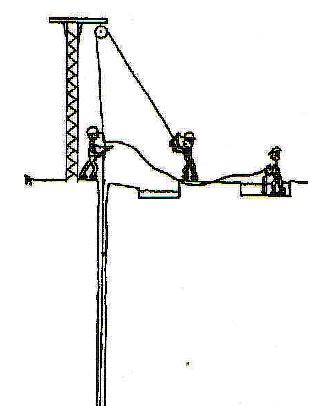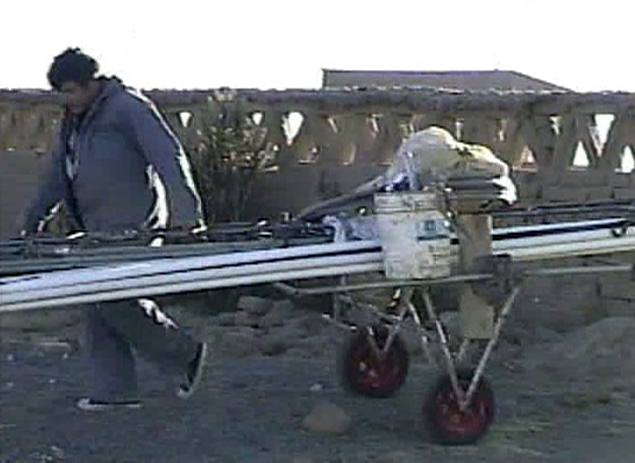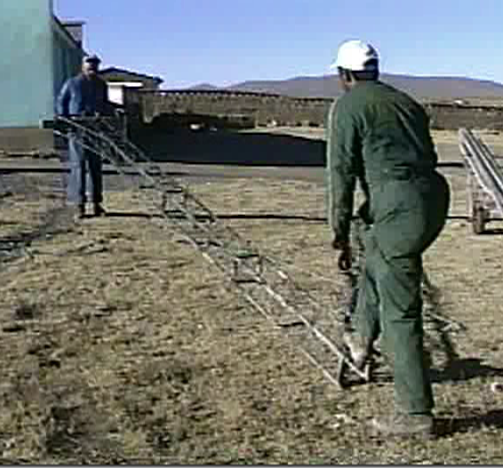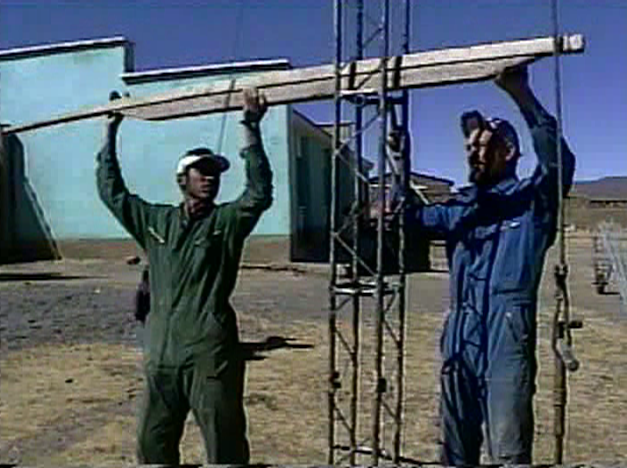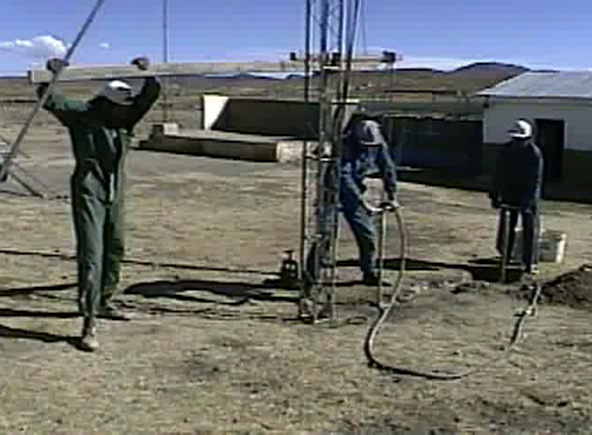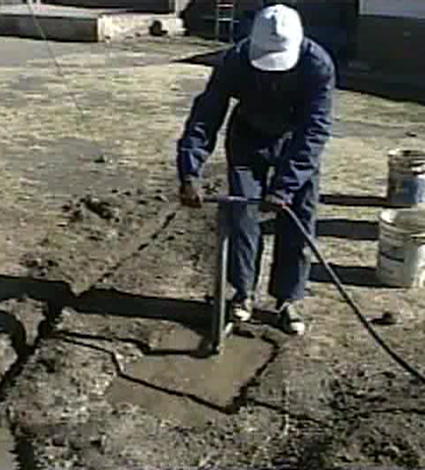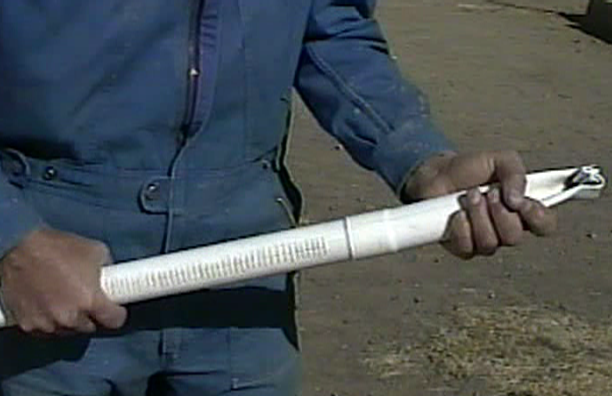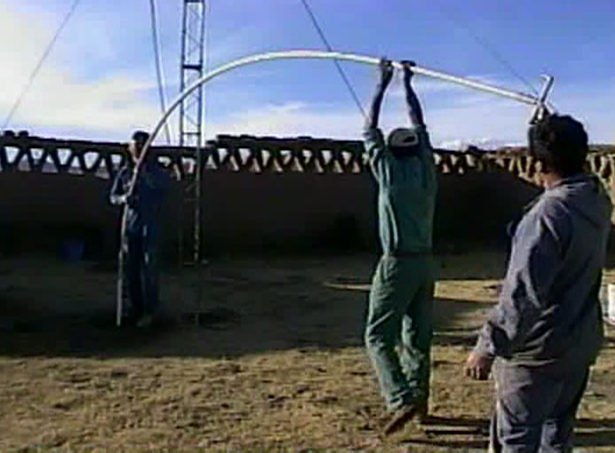Jetting - EMAS method
The EMAS method of manual drilling is a hybrid between Jetting, percussion, and rotary drilling. A manually powered mud pump is used, and the drill stem is turned through 90 degrees at the end of each stroke. It permits to drill through all kinds of loose soils, as well as consolidated materials and light rock. It will not, however, penetrate hard original rock or boulders (e.g. ancient river beds underground). The usual diameter of the tube well is 37 mm.
History and social context
The EMAS drilling method was developed by the Escuela Móvil de Agua y Saneamiento (Mobile School for Water and Sanitation, EMAS) in Bolivia. Project leader of EMAS in Bolivia is Wolfgang Eligius Buchner, born 1957 in Holzkirchen bei München.
EMAS was established in 1993, and has provided training for about 130 independent well builders in its branches in San Julian (1994) and in Puerto Pérez (1997). 20 students have been able to graduate from the licensed craftsman course. The well builders in Bolivia have founded a well builder organization.
During a three-month education, agricultural workers are trained to independently drill wells, build sanitary installations and market their skills in their local area depending on demand. The need for large financial investments for well drilling and the building of line systems has traditionally prohibited the construction of large scale potable water systems in rural areas. Wolfgang Buchner adapted already accepted suction - and rinsing drilling methods to local conditions.
EMAS is not only the name of the mobile school for water and sanitation, but also a whole technical and social concept of water and sanitation which includes rain water harvesting, solar water heaters, windpower, hydraulic rams, water treatment, small tanks and sinks, a variety of hand and foot pumps, and ferrocement tanks.
Suitable conditions
Wells as deep as 90 meters can be drilled within 3-4 days without any machine employment and exclusively through the use of manual labor. Depths up to 100 m have been reached with the EMAS method. Most regions of South America (loam and sandy soils) are geologically suitable for this drilling method (predominantly rinsing or suction drilling).
This technique is suitable for weakly cohesive sands and silts. It adapts best to loamy soils, consolidated materials and light rock. In sticky clays, the mud injection orifices in the bit can get blocked. In pure coarse sands, progress may be slow: the space between the drill stem and the well walls is relatively large, in relation to the slender drill stem, which makes for a slow upward flow. Sand may sink faster than it can be lifted out with the drilling fluid. In such conditions, it may be beneficial to (temporarily) switch to a sludging technique.
| Advantages | Disadvantages/limitations |
|---|---|
| - Very quick in fine and medium sand formations. - Very simple and cheap equipment. |
- Generally limited to sandy soils. Soft clay will be penetrated only very slowly and coarse gravel and other highly permeable materials (cracks in the formation) cause loss of working water and cannot be drilled. The borehole stays open by water pressure. To prevent collapsing fluid-drilled boreholes must be kept full of water during the entire drilling and well installation process. - Enough working water needs to be available on the drilling location. |
Technical specification
Operation
Drilling is continuous: the drill bit is normally not removed from the borehole until it is finished or work is interrupted. As a portion of the drill stem is entered, another length of ¾” (19 mm) metal pipe with reinforced threads is screwed on. Drilling fluid (mud, a suspension of ordinary clay or bentonite with an adequate density) is pumped down through the drill stem using a hand-operated mud pump. The drilling fluid comes back up around the drill stem, carrying broken-up material. Sand and small stones settle in a settling area dug in the ground, and the mud is recycled through the pump.
Percussion action is performed by lifting the drill with a lever, mounted on the drilling tower, and letting it fall down. Moreover, the drill is rotated half-turns in both directions, enhancing the grinding action of the bit.
The resulting hole diameter is about two inches, and wells are cased with cheap 1 1/2” (39 mm) PVC pipe. This can accommodate a 1 1/4” PVC piston pump, but if required, the upper portion of the well (down to about 1 m below the lowest expected water table) can be reamed to accommodate larger diameter pumps.
As the entire drill stem is metallic, the weight of the drill increases linearly with depth, so the deeper the well, the heavier the stroke, but stroke length is limited to about 30 cm by the lever.
No temporary casing is used. Upon reaching the desired depth, drilling fluid is removed from the hole by injecting progressively lower density mud. If unstable layers are present, however, this diluting can make the well collapse before it can be cased. In such cases it may be better to case the well with mud in it and evacuate the mud afterwards by pouring or injecting water into the casing (backwashing).
Maintenance
Manufacturing
The complete rig can be built locally in about any arc-welding workshop, using only materials found in ordinary hardware stores.
Cost
An EMAS drilling rig, fit to drill holes up to 30 m deep, can be built in Bolivia for about US$ 600 - 800. This includes the tower, mud pump and all essential non-common tools to operate and maintain it.
In most cases, the tube well is combined with an EMAS hand pump. In that case, the total cost per meter, including labor, materials, hand pump and 1 year warranty, in Bolivia amounts to between 4 and 10 US$. The standard price is between 5 and 6 Dollars per meter.
That price is calculated in 3 parts. Taking 6$ as basis, 2$ are for the material and hand pump (a hand pump is normally included in a well deeper than 20 meters), 2$ are for the wage of the two drillers (including also the maintenance of the equipment) and 2$ in the creation of a reserve fund in case there is no water or not enough water found, salty water found or a drilling mistake is made such as a broken drill stem, the wrong filter sleeve, etc. Normally, for the price of 5$ a 1 year warrantee is given in case that the sand remains after 4 weeks use.
The average well depth in Bolivia is around 27 meters, and costs approx. US$ 180 including an EMAS hand pump. This makes a surface covering supply of drinking water possible for municipalities and families in rural areas.
Country experiences
The EMAS method is mainly used in Bolivia, Panama, Ecuador, Paraguay, Brazil, Peru, Honduras, Nicaragua, El Salvador, Guatemala, Eritrea and Sri Lanka.
Manuals
- EMAS have produced a set of DVDs which cover, among others EMAS drilling and other low cost water supply techniques. Contact Wolfgang Buchner on [email protected] if you would like to order a copy. The movies will also be made available on the web.
Movies
- Standard EMAS well drilling, by Wolfgang Buchner
- [Required materials for standard EMAS well drilling]
- Suction variant to standard EMAS method
- Sluding with temporary casing
- Large collection of EMAS movies on different subjects.
External Links
- EMAS - Website of EMAS on EMAS well drilling
- Article on EMAS drilling by Paul Cloesen.
- Rural Water Supply Network, article on EMAS drilling. General manual drilling section of RWSN website.
References
- This article is based on an article by Paul Cloesen, and on material from www.emas-international.de
